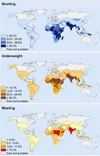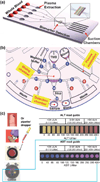Microfluidic opportunities in the field of nutrition
- PMID: 24056522
- PMCID: PMC3875330
- DOI: 10.1039/c3lc90090h
Microfluidic opportunities in the field of nutrition
Abstract
Nutrition has always been closely related to human health, which is a constant motivational force driving research in a variety of disciplines. Over the years, the rapidly emerging field of microfluidics has been pushing forward the healthcare industry with the development of microfluidic-based, point-of-care (POC) diagnostic devices. Though a great deal of work has been done in developing microfluidic platforms for disease diagnoses, potential microfluidic applications in the field of nutrition remain largely unexplored. In this Focus article, we would like to investigate the potential chances for microfluidics in the field of nutrition. We will first highlight some of the recent advances in microfluidic blood analysis systems that have the capacity to detect biomarkers of nutrition. Then we will examine existing examples of microfluidic devices for the detection of specific biomarkers of nutrition or nutrient content in food. Finally, we will discuss the challenges in this field and provide some insight into the future of applied microfluidics in nutrition.
Figures




Similar articles
-
Potential Point-of-Care Microfluidic Devices to Diagnose Iron Deficiency Anemia.Sensors (Basel). 2018 Aug 10;18(8):2625. doi: 10.3390/s18082625. Sensors (Basel). 2018. PMID: 30103424 Free PMC article. Review.
-
Microfluidic assessment of nutritional biomarkers: Concepts, approaches and advances.Crit Rev Food Sci Nutr. 2024;64(15):5113-5127. doi: 10.1080/10408398.2022.2150597. Epub 2022 Dec 11. Crit Rev Food Sci Nutr. 2024. PMID: 36503314 Review.
-
Microfluidic-integrated biosensors: prospects for point-of-care diagnostics.Biotechnol J. 2013 Nov;8(11):1267-79. doi: 10.1002/biot.201200386. Epub 2013 Sep 6. Biotechnol J. 2013. PMID: 24019250 Review.
-
Recent advances in microfluidic sample preparation and separation techniques for molecular biomarker analysis: A critical review.Anal Chim Acta. 2017 Sep 15;986:1-11. doi: 10.1016/j.aca.2017.07.043. Epub 2017 Jul 24. Anal Chim Acta. 2017. PMID: 28870312 Free PMC article. Review.
-
Nanomaterial-assisted microfluidics for multiplex assays.Mikrochim Acta. 2022 Mar 11;189(4):139. doi: 10.1007/s00604-022-05226-4. Mikrochim Acta. 2022. PMID: 35275267 Review.
Cited by
-
Potential Point-of-Care Microfluidic Devices to Diagnose Iron Deficiency Anemia.Sensors (Basel). 2018 Aug 10;18(8):2625. doi: 10.3390/s18082625. Sensors (Basel). 2018. PMID: 30103424 Free PMC article. Review.
-
Detection of contaminants in water supply: A review on state-of-the-art monitoring technologies and their applications.Sens Actuators B Chem. 2018 Feb;255:2657-2689. doi: 10.1016/j.snb.2017.09.078. Epub 2017 Sep 18. Sens Actuators B Chem. 2018. PMID: 32288249 Free PMC article. Review.
References
-
- World Health Organization. Global nutrition policy review: what does it take to scale up nutrition action? 2013
-
- Flegal KM, Carroll MD, Kit BK, Ogden CL. JAMA: the Journal of the American Medical Association. 2012;307:491. - PubMed
Publication types
MeSH terms
Substances
Grants and funding
LinkOut - more resources
Full Text Sources
Other Literature Sources

